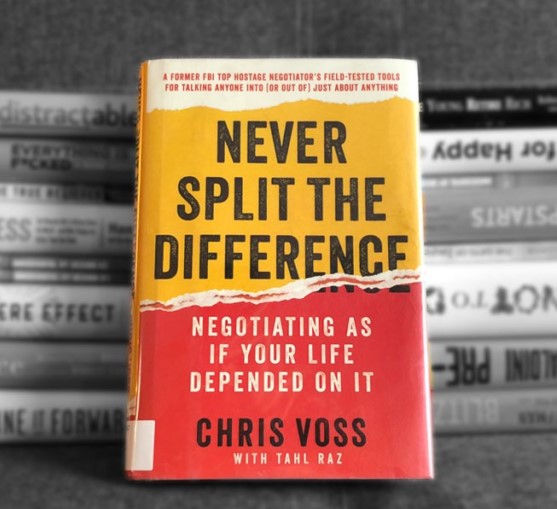A few months back, I was shopping around to replace the faulty front brake of my bicycle that I would be using for my Powerman event.
The bike mechanic, let’s say his name is Samir, told me the price; it was RM 260 for a set of front and rear brakes.
Man, they’re way out of my skimpy ass budget.
I tried to ask for cheaper alternatives. Maybe second or third-tier brands, or maybe just 1 pair instead of 2, or maybe just fix the components that are broken on my brake set.
After a while he told me that he might have a used set just for the front brake. Suddenly, my bulb is lighting and I’m willing to pay anything other than RM 260. He put the price at RM140 for a pair of used brakes and I think they’re a steal.
I don’t know if it was a steal or I just got played. During my way back home, I just realized that Samir, just hit me with a psychological trick called “Price Anchoring”.
Never Split The Difference
A few months ago, I read Never Split The Difference by Chris Voss. Price Anchoring is just one of the concepts that I learnt from the book.
The writer, Chris Voss, is an FBI hostage negotiator. As his job implies, he does negotiating for a living. And in his world, failing to negotiate, meaning loss of lives.
When talking about negotiating, we probably pictured haggling in the pasar malam. However, negotiating is all around us. We negotiate with our potential employees for a higher salary. We negotiate for better terms phone bills.
That’s why when a master negotiator writes a book, we read and then steal the golden nuggets. Here are the 5 tips that I learned from the book.
1 - Mirroring
A few months back, I was shopping around to replace the faulty front brake of my bicycle that I would be using for my Powerman event.
The bike mechanic, let’s say his name is Samir, told me the price; it was RM 260 for a set of front and rear brakes.
Man, they’re way out of my skimpy ass budget.
I tried to ask for cheaper alternatives. Maybe second or third-tier brands, or maybe just 1 pair instead of 2, or maybe just fix the components that are broken on my brake set.
After a while he told me that he might have a used set just for the front brake. Suddenly, my bulb is lighting and I’m willing to pay anything other than RM 260. He put the price at RM140 for a pair of used brakes and I think they’re a steal.
I don’t know if it was a steal or I just got played. During my way back home, I just realized that Samir, just hit me with a psychological trick called “Price Anchoring”.
2 - Tactical Empathy
The centerpiece theme of this book is Tactical Empathy, which Chris describes as:
Tactical Empathy is understanding the feelings and mindset of another in the moment and also hearing what is behind those feelings so you increase your influence in all the moments that follow. It’s bringing our attention to both the emotional obstacles and the potential pathways to getting an agreement done. It’s emotional intelligence on steroids.
Tactical empathy is the ability to think from another person’s point of view while they are talking and slowly trying to assess their motivation, goals and what is really driving them.
The best way to show tactical empathy is by summarizing and reflecting. After they speak, summarise their key points and reflect their emotions. For example, “It sounds like you’re feeling sad because…”
3 - Accusation Audit
Accusation audit is taking the time to prepare before you enter a negotiation or conflict. Try to label 5 to 10 perceptions or accusations that they might throw at you.
Then, early on in the negotiation, disarm their accusation by acknowledging them. IT can goes like this:
I know you feel that I’m not putting 100% effort in my work. Yes, I do feel like I’m not giving the best in my latest work but I am actually working on making improvements on that.
These acknowledgements are important to show that you’re self-aware and are addressing the root cause of the problems.
4 - Name Your Price. Prince Anchoring
Accusation audit is taking the time to prepare before you enter a negotiation or conflict. Try to label 5 to 10 perceptions or accusations that they might throw at you.
Then, early on in the negotiation, disarm their accusation by acknowledging them. IT can goes like this:
I know you feel that I’m not putting 100% effort in my work. Yes, I do feel like I’m not giving the best in my latest work but I am actually working on making improvements on that.
These acknowledgements are important to show that you’re self-aware and are addressing the root cause of the problems.
5 - Calibrated Questions
Calibrated questions are basically saying “no” in a different way by framing the questions back to the counterparts. For example:
A: I want RM1000 by tonight.
Calibrated Questions: How can I get that kind of money tonight when I only have RM 200 in my bank?
Calibrated questions subtly explain your situation or get your counterparts to see from your point of view. A well calibrated question also gives your counterparts the illusion of control and this is good.
Other calibrated question examples:
- “What would need to happen for that to be possible?”
- “What are your concerns about that approach?”
Pair calibrated questions with accusation audit.
Conclusions
These are some of the lessons that I learnt from reading Never Split The Difference by Chris Voss.
While these techniques are quite powerful, it’s crucial to use them ethically and respectfully. Avoid trying to be manipulative and always strive to achieve a mutually beneficial outcome.
Next time you’re in a job interview, you can hit your potential employee with your own version of price anchoring, just like Samir did to me.
Let’s say if you want your salary to be RM 5000, hit your potential employer with a price anchoring at RM 5500. This is extreme anchoring and their first response will probably be a no.
Then, we started to negotiate down to around RM 5000. Since RM 5000 sounds way better than RM 5500 from an employer perspective, they will think they have saved up RM 500, but it is actually your target all along. That’s a win-win!
These skills take time and practice to master. Experiment these techniques in low-stakes situations such as negotiating for a cheaper price or an extra kuih the next time you’re in the pasar malam before applying them in high-pressure negotiations.



